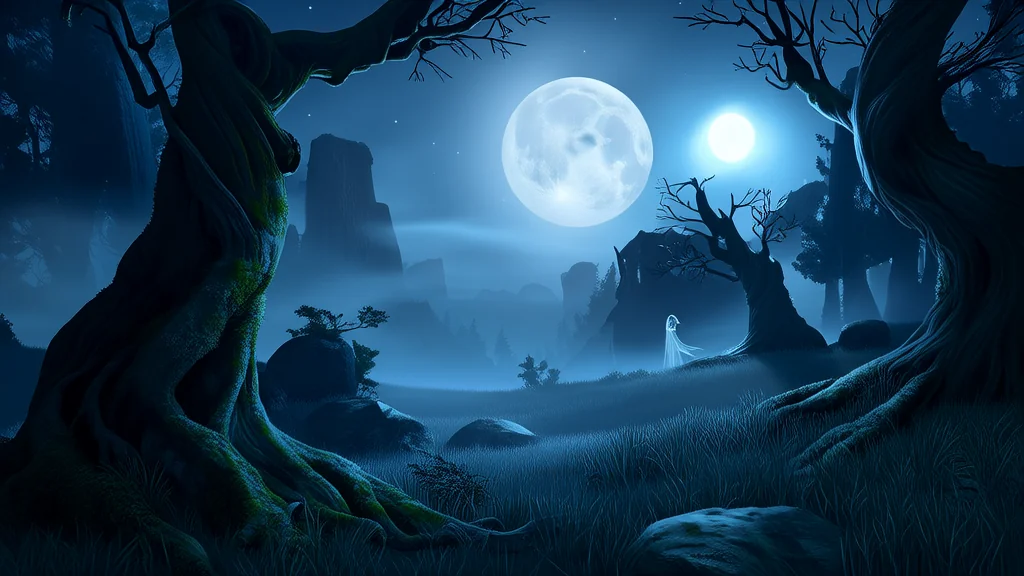🔮 Weird Tales & Urban Legends
Whispers in the Fog: The Wraithbeast That Stalks the Moonlit Valley

In the remote mountains of a forgotten valley, where the fog clings to the trees like a ghostly shroud, there is a legend whispered only by the old ones. They speak of the Wraithbeast, a creature that appears only when the moon is full and the wind howls through the pines with an unnatural voice. No one has ever seen it clearly, but many claim to have felt its presence—like a cold breath on the back of their necks, or the sudden silence of the forest as if the world itself holds its breath.
The story begins with a young naturalist named Elias, who had heard the tales as a child but dismissed them as mere folklore. He was a man of science, not superstition, and he came to the valley in search of rare flora and fauna. The local villagers, however, watched him with wary eyes, as if they knew something he did not. They warned him to stay away from the eastern ridge, where the trees grew twisted and gnarled, and where no birds dared to sing.
Elias ignored their warnings. He set up camp near a small stream, sketching plants and collecting samples. Each night, he would sit by the fire, listening to the rustling leaves and the distant hoot of an owl. But as the days passed, the silence around him deepened. The usual sounds of the forest—the chirping of insects, the crackle of branches underfoot—began to fade, replaced by an eerie stillness.
On the third night, Elias awoke to the sound of something moving in the darkness. It was not the wind, nor the shifting of the trees. It was a low, guttural sound, like a growl that echoed from the depths of the earth. He grabbed his flashlight and stepped outside, his breath visible in the cold air. The fog had thickened, curling around the trees like smoke. He could see nothing, but he could feel it—something watching him.
He turned off the light and stood motionless, heart pounding. Then, from the corner of his eye, he saw it: a shadow, tall and thin, moving between the trees. It was not human, nor animal. Its form was fluid, shifting as if it were made of mist and bone. When it turned, its face was hidden, but he could sense its gaze upon him, hollow and empty.
Elias ran back to his tent, slamming the zipper shut behind him. His hands trembled as he lit a candle, the flame flickering wildly. He tried to rationalize what he had seen, but the logic of science failed him. This was not a trick of the mind, nor a hallucination. It was real.
The next morning, he found his supplies disturbed. A journal was open, pages turned as if someone had been reading them. His camera, which had been securely stored, was now pointing toward the ridge, as if it had been used to capture something. He didn’t remember taking any pictures. He didn’t remember anything after the encounter.
Days passed, and the village elders approached him. They spoke in hushed tones, offering him food and shelter. They told him that the Wraithbeast was not a creature of flesh, but a spirit bound to the land. It was said to be the remnants of a long-forgotten people, trapped between worlds, seeking something they had lost. Some believed it was a guardian, others a curse. No one knew for sure.
Elias tried to leave, but the path back seemed to change each time he attempted it. The forest became a maze, the trees shifting subtly, leading him in circles. He began to sleep less, haunted by dreams of the creature. In one, it stood before him, its form solid now, its eyes glowing with an ancient sorrow. It reached out, not to harm, but to touch. And in that moment, he understood.
It was not a monster. It was a memory. A being of the past, caught in the present, searching for meaning in a world that had forgotten it.
But why had it chosen him?
One final night, Elias returned to the ridge, carrying only a lantern and a notebook. He walked until the trees parted, revealing a clearing bathed in silver moonlight. There, standing at the edge of a stone circle, was the Wraithbeast. This time, it did not move. It simply waited.
He stepped forward, unsure of what to say. The creature tilted its head, as if listening. Then, without warning, it raised a hand—long, pale, and skeletal—and pointed toward the center of the circle. There, half-buried in the earth, was an object: a carved stone tablet, covered in symbols that pulsed faintly with light.
Elias knelt, brushing away the dirt. As his fingers touched the stone, a whisper filled the air—not words, but emotions. A longing, a grief, a yearning for connection. He realized then that the Wraithbeast was not seeking to harm, but to be remembered.
He left the tablet untouched, but took a photograph with his camera, which had mysteriously returned to his pack. He never spoke of what he saw, and the villagers never asked. But in the years that followed, strange things began to happen in the valley. Flowers bloomed where none should, and the wind carried melodies no one could place. Some said the Wraithbeast had found peace. Others said it was just beginning.
And still, every full moon, the forest falls silent, waiting.
Published on en
🔗
Related Sites
- AI Blog — AI trends and tech news